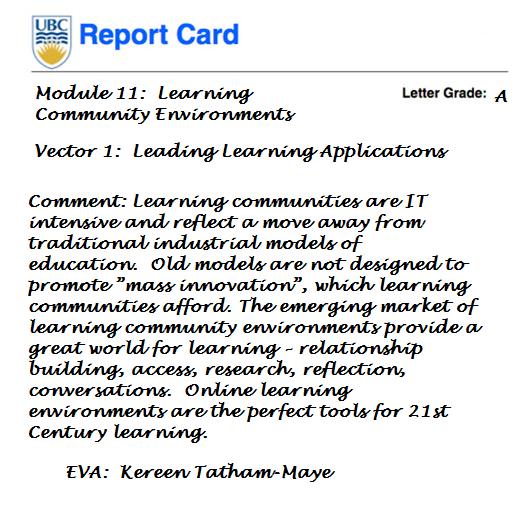Course:ETEC522/2010ST1/LearningCommunityEnvironments/Vector 1-Leading Learning Applications
Prescribed Learning Outcome
By the end of this vector, ETEC522 participants should be able to:
1. suggest possible reasons for joining online learning communities within the K-12 learning context
2. identify factors to be considered before joining online learning communities using a case study
Vector 1: Leading Learning Applications
The death of education...
...the dawn of learning communities...
Like the development and implementation of any innovation, building successful online learning communities requires good planning. Vrasidas (2004) noted that although there is no step-by-step approach that guarantees success, some general guidelines for developing online communities include:
... people who cannot meet face-to-face because of place and time constraints and who meet online to work together on a shared task...
... clearly defined tasks and sub-tasks on which members work online, giving participants a clear understanding of the expectations...
... accessible and usable tools for communication...
... easy access to technology and Computer Supported Collaborative Work tools is available to all members...
... good leadership and co-ordination of online activities...
... on-going interaction among members is based on constructive dialogue...
... a system is in place to monitor participants' behaviour and participation ...
... a safe environment where participants can freely express their opinion and ask questions without fear of being attached...
... completed activities are evaluated regularly and feedback is provided in a timely manner...
...smaller groups within the community provide a peer-support group, which is smaller than the larger community...
What is the purpose of learning communities?
One of the first adopters of online learning community is the Star-Online Consortium Model. United Star Distance Learning Consortium (USDLC) is a nonprofit multistate educational consortium committed to excellence in teaching through blended technologies. It aims to ensure that all students and educators in K-12 and higher learning institutions in America, regardless of circumstances or geographic location have eqitable access to high quality educational opportunities. USDLC was incorporated in 1997 and has received Educational Access Channels from Direct TV and DISH network. Infrastructural adjustments have also made it possible to move toward web-based curriculum, web-streaming and online services.
USDLC began as a leader in satellite delivery of distance education courses and professional development then transitioned to teaching and learning through blended technologies. It hopes to continue its series of 3D programs designed to give teachers a chance to hear from and talk with outstanding teachers who are leading the way in new learning technologies, including: Web 2.0, 1:1 computing, robotics, and serious gaming/3D Web. Fittingly, the series is produced in the 3D online, virtual world of Second Life as well as offered via Internet Radio with chat for interactivity for non-Second Life citizens.
In 2000, the US Department of Education awarded the United Star Distance Learning Consortium for the STAR-Online project. Star-Online (Supporting Teachers with Anywhere/Anytime Resources) is a model for continuing education and professional development for teachers in the US. This online staff development provides pre-service, new and veteran teachers with training, support and communication links necessary for their continued success in the classroom. Teachers can access mentors, colleagues and resources via web-based Virtual Teaching and Learning Community (VTLC) system. The VTLC is an online, interactive self-paced staff development model, which allows teachers to gain knowledge and skills in the application of educational technology.
Once a teacher has registered to use Star-Online's VTLC, they will obtain a login ID and password. Afterwhich, they are required to answer pre-survey questions. This provides suggested learning modules based on teachers' skills level and interest. All data is housed on each teacher's personal eportfolio. After successful completion of the pre-survey instrument, teachers may then use any of the personal development resources in the VTLC. These resources include Teacher Resources, Communication tools, and other online modules. The communication tools support peer collaboration, mentoring, and technical support for teachers. Some communication tools that are available to support peer collaboration and technical support include Listserv, chatroom, bulletin board, and SHARE database of lesson plans.
The CUBE:
1. When assessed against the cube, Star-Online in the emerging market of online learning communities appears to be in good standing for continued success. With a market focus on training needs of teachers, Star-Online will continue to be an attractive market, as the coorporate market (training of employees) has created the world's largest technology companies.
2. As an infrastructure provider, Star-Online delivers content/courses that are closely aligned to the unique needs and realities of the education environment - giving teachers the tools to sustain 21st Century learning/literacies.
3. With Star-Online learning community, teachers are the buyers. These learning solutions are purchased through e-commerce systems as students enroll online. As such, the consumer is also the buyer. All Components of Star-Online's learning product is for an Affordable Price of $125 annually or $65 per Semester.
4. As it relates to other forms of learning, Star-Online aligns well with international educational technology standards such as ISTE and works with a well developed learning system designed to handle the upgrading of teachers' credentials. Additionally, Star-Online product provides ongoing and timely feedback through online specialist/mentors. It's also functional on cross platforms and is browser friendly.
5. With regards to the global market, Star-Online is well positioned for the Wired Anglophone Country as it's product currently comes only in English and is solely offered in the USA. As such, a major limitation of the Star-Online product is that it's not produced for export.
Discussion
1. Please read the case study on Bayside Academy and discuss your answer on the Wordpress discussion area.
2. Why are people drawn to learning communities like Edline?
Vector Report Card
References
Vrasidas, C.and Michhelinos, Z. (2004). The Design of online learning communities: Critical Issues. Educational Media International
Learning to change video: http://www.youtube.com/watch?v=tahTKdEUAPk
We Think video: http://www.youtube.com/watch?v=qiP79vYsfbo
Continue to Vector 2: Leading Solution Providers
Return to Course:ETEC522/2010ST1/LearningCommunityEnvironments
